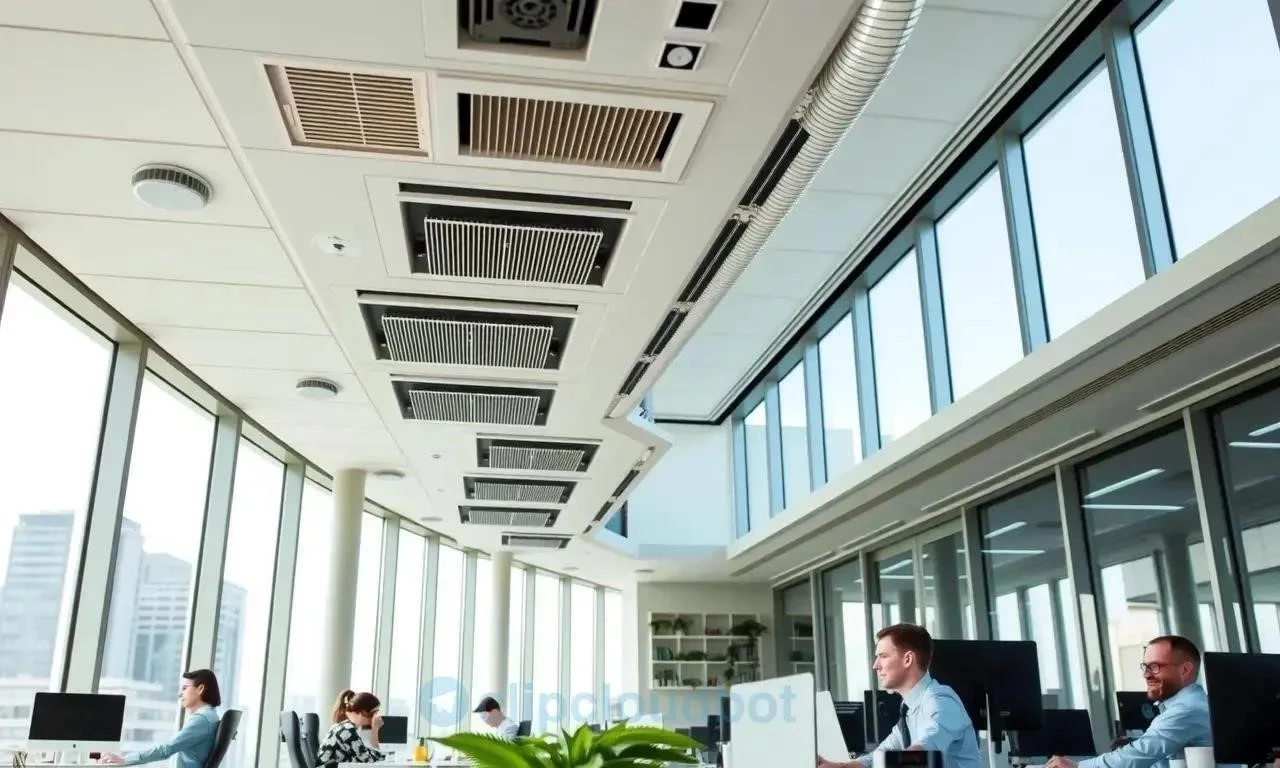In today’s world‚ where we spend a significant portion of our lives indoors‚ the importance of good ventilation in the workplace cannot be overstated. Beyond simply providing fresh air‚ effective ventilation systems play a critical role in maintaining a safe‚ healthy‚ and productive environment for employees. Insufficient ventilation can lead to a build-up of pollutants‚ allergens‚ and even infectious agents‚ negatively impacting employee well-being and potentially leading to decreased productivity and increased absenteeism. Therefore‚ understanding and prioritizing proper ventilation is crucial for any responsible employer.
Why Good Ventilation Matters
Good ventilation is essential for a variety of reasons. It helps to:
- Remove stale air and replace it with fresh air.
- Dilute and remove airborne pollutants such as dust‚ fumes‚ and volatile organic compounds (VOCs).
- Control temperature and humidity levels.
- Reduce the spread of airborne illnesses.
- Improve overall air quality and create a more comfortable work environment.
Health Benefits of Proper Ventilation
The health benefits of proper ventilation are numerous and can significantly impact employee well-being. These benefits include:
- Reduced risk of respiratory problems: Proper ventilation helps to remove allergens and irritants from the air‚ reducing the risk of asthma attacks‚ allergies‚ and other respiratory issues.
- Improved concentration and cognitive function: Fresh air and a comfortable environment can improve focus and concentration‚ leading to increased productivity.
- Decreased spread of illness: Ventilation helps to dilute and remove airborne viruses and bacteria‚ reducing the risk of employees getting sick;
- Reduced sick leave: By improving overall health and reducing the spread of illness‚ proper ventilation can lead to fewer sick days taken by employees.
- Improved sleep quality: Spending time in a well-ventilated environment can improve sleep quality‚ leading to increased energy levels and improved overall health.
Comparing Ventilation Systems
There are several different types of ventilation systems available‚ each with its own advantages and disadvantages. The best system for a particular workplace will depend on factors such as the size of the space‚ the type of work being done‚ and the budget.
| Feature | Natural Ventilation | Mechanical Ventilation | Hybrid Ventilation |
|---|---|---|---|
| Cost | Low initial cost‚ but may require modifications to building design. | Higher initial and operational costs. | Moderate initial and operational costs. |
| Control | Limited control over airflow and temperature. | Precise control over airflow‚ temperature‚ and humidity. | Combines natural and mechanical methods for flexible control. |
| Effectiveness | Dependent on weather conditions and building design. | Highly effective in all weather conditions. | Effectiveness varies depending on the system design and weather conditions. |
| Energy Consumption | Low energy consumption. | High energy consumption. | Lower energy consumption than purely mechanical systems. |
FAQ About Workplace Ventilation
Q: What are the signs of poor ventilation?
A: Signs of poor ventilation include stale or stuffy air‚ condensation on windows‚ mold growth‚ and a general feeling of discomfort.
Q: How often should ventilation systems be inspected and maintained?
A: Ventilation systems should be inspected and maintained regularly‚ typically at least once a year‚ to ensure they are functioning properly.
Q: What is the recommended air exchange rate for an office environment?
A: The recommended air exchange rate varies depending on the specific environment and the number of occupants‚ but generally‚ a minimum of 5-6 air changes per hour is recommended.
Q: Can poor ventilation affect employee productivity?
A: Yes‚ poor ventilation can lead to decreased concentration‚ fatigue‚ and headaches‚ all of which can negatively impact employee productivity.
Q: What are some simple ways to improve ventilation in the workplace?
A: Simple ways to improve ventilation include opening windows‚ using fans‚ and ensuring that ventilation systems are properly maintained.
Investing in good ventilation is an investment in the health‚ well-being‚ and productivity of your employees. By prioritizing proper ventilation‚ employers can create a healthier and more comfortable work environment‚ leading to a more engaged and productive workforce. Consider evaluating your current ventilation system and making necessary improvements to ensure a safe and healthy workplace for everyone.
Investing in good ventilation is an investment in the health‚ well-being‚ and productivity of your employees. By prioritizing proper ventilation‚ employers can create a healthier and more comfortable work environment‚ leading to a more engaged and productive workforce. Consider evaluating your current ventilation system and making necessary improvements to ensure a safe and healthy workplace for everyone.
My Journey with Workplace Ventilation
I’ve seen firsthand the difference good ventilation can make. I remember when I joined “TechForward Solutions‚” a bustling software development company. The team was sharp‚ the projects were exciting‚ but the office… the office was a nightmare. It always felt stuffy‚ even in winter. Headaches were rampant‚ and productivity seemed to peak around 10 AM‚ only to nosedive after lunch. It was awful. I started to feel sick from the poor air quality.
The Turning Point
After a particularly brutal week of constant headaches and brain fog‚ I decided to take matters into my own hands. I started small. I brought in a portable air purifier for my desk area. It helped a little‚ but the problem was clearly bigger than just my corner. Then‚ I began documenting the issues. I kept a log of the air quality issues. The frequency of headaches‚ the times the air felt particularly stale‚ and the general discomfort reported by my colleagues. I presented this information to management‚ along with some research on the benefits of improved ventilation.
Implementing Change
To my surprise‚ they listened! After reviewing my data‚ they agreed to invest in a new‚ more efficient HVAC system. The process wasn’t instant. There were contractors to hire‚ installation schedules to coordinate‚ and the inevitable disruptions that come with any major renovation. During the transition‚ we used several portable air purifiers and regularly opened the windows (weather permitting‚ of course!). It was a joint effort from everyone in the team.
The Results
The difference was remarkable. Once the new system was up and running‚ the air quality improved dramatically. The stale‚ stuffy feeling vanished. Headaches became far less frequent. But the most surprising change? Productivity skyrocketed. People were more focused‚ more energetic‚ and generally happier to be at work. I even noticed a decrease in sick days taken. It was like breathing new life into the entire company. It was a very big relief to me.
Lessons Learned
This experience taught me a valuable lesson about the importance of advocating for a healthy work environment. It wasn’t easy‚ and required me to step out of my comfort zone. Now‚ I am more confident and I am not afraid to speak up. I also learned that even small changes‚ like adding air purifiers or simply opening windows‚ can make a difference‚ but that a comprehensive solution is often the best approach. It was quite rewarding to see the positive impact that I made.
Further Adventures in Air Quality
The success at TechForward Solutions ignited a passion for air quality in me. I became somewhat obsessed! I started researching different ventilation systems‚ learning about MERV ratings‚ air exchange rates‚ and the impact of various pollutants on indoor air. I felt like an amateur scientist‚ constantly experimenting and trying to understand the complexities of breathing clean air.
The Case of the Stuffy Studio Apartment
My next challenge came closer to home – my own studio apartment. It was a charming space‚ full of character‚ but notoriously stuffy. I tried everything. I opened windows constantly (even when it was freezing!)‚ bought a fancy HEPA filter‚ and even tried some DIY air purifying hacks I found online (activated charcoal‚ anyone?). While these efforts provided some marginal improvements‚ the air still felt heavy and stagnant.
Diving into DIY Solutions
That’s when I decided to get a bit more technical. I purchased an inexpensive air quality monitor online. It measured particulate matter (PM2.5)‚ volatile organic compounds (VOCs)‚ and carbon dioxide levels. The results were… alarming. My PM2.5 levels were consistently high‚ especially when I was cooking. And my VOC levels spiked after using cleaning products. It was clear I needed a more targeted approach.
Experimenting with Exhaust Fans and Air Sealing
I started by focusing on the kitchen‚ the primary source of my PM2.5 spikes. I installed a small exhaust fan above the stove. It wasn’t a perfect solution‚ but it significantly reduced the smoke and odors that lingered after cooking. Next‚ I tackled the VOC problem. I switched to natural cleaning products and made sure to properly ventilate the apartment after using anything that emitted strong fumes. Then I focused on sealing the windows with weather stripping. The sealing helped to prevent air infiltration from outside which resulted in a more controlled environment inside.
The Long-Term Impact
Over time‚ these small changes made a noticeable difference. The air in my apartment felt cleaner‚ fresher‚ and less oppressive. I slept better‚ had more energy‚ and generally felt healthier. It was a testament to the power of even basic ventilation strategies. More importantly‚ it validated my initial passion. I knew that I could make a real difference in people’s lives just by improving the air they breathed.
My New Mission: Spreading the Word
Now‚ I’m on a mission to share my knowledge and experiences with others. I volunteer at local community centers‚ giving workshops on indoor air quality. I write articles for online publications. And I even consult with small businesses‚ helping them create healthier and more productive work environments. It’s incredibly rewarding to see the positive impact of my work. It’s more than just a job; it’s a passion. And it all started with a stuffy office and a persistent headache.





